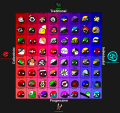Left-Rothbardianism, also called Left-Voluntarism, is an economically centre-right, anarchist and culturally ambiguous ideology that is the child of ![]() Left-wing Market Anarchism and
Left-wing Market Anarchism and ![]() Anarcho-Capitalism.
Anarcho-Capitalism.
Left-Rothbardianism believes in a ![]() Neo-Lockean homesteading principle.[1]
The principle as a whole states that property can only be legitimately owned by 2 means, direct trade from the past owner or applying your labor to un-owned land, and it uses this principle to found its claim on the confiscation of "private" property,[2] specifically the part where it states that applying your labor to un-owned property (Apllying it to 'ill-gotten property') is legitimate leads to legitimate ownership of said property.
Neo-Lockean homesteading principle.[1]
The principle as a whole states that property can only be legitimately owned by 2 means, direct trade from the past owner or applying your labor to un-owned land, and it uses this principle to found its claim on the confiscation of "private" property,[2] specifically the part where it states that applying your labor to un-owned property (Apllying it to 'ill-gotten property') is legitimate leads to legitimate ownership of said property.
The difference between the ![]() Classical homesteading principle and the
Classical homesteading principle and the ![]() Neo-Lockean principle is that the first one also accepts the Lockean proviso as legitimate, which states that the homesteading principle only applies as long as there is enough and of the same quality for everybody else, while the Neo-Lockean principle rejects this proviso.
Neo-Lockean principle is that the first one also accepts the Lockean proviso as legitimate, which states that the homesteading principle only applies as long as there is enough and of the same quality for everybody else, while the Neo-Lockean principle rejects this proviso.
Despite the ![]() Left- prefix of the name this ideology, which could make some people think this is a socialist ideology, it heavily advocates for the respect of private property[3] as a natural right that derives from the right of self-ownership, but they don't see property as legitimate if its a derivative of coercion, which includes, if the property derives from
Left- prefix of the name this ideology, which could make some people think this is a socialist ideology, it heavily advocates for the respect of private property[3] as a natural right that derives from the right of self-ownership, but they don't see property as legitimate if its a derivative of coercion, which includes, if the property derives from ![]() state benefits.
state benefits.
They oppose the common consensus that ![]() government regulation helps to eliminate or mitigate oppression by big corporations, saying that furthermore the state is the source of the problem it says to solve.
It also opposes the view of the
government regulation helps to eliminate or mitigate oppression by big corporations, saying that furthermore the state is the source of the problem it says to solve.
It also opposes the view of the ![]() Gilded Age as a
Gilded Age as a ![]() Laissez-Faire period where the state didn't have interference and where the free market ran the world, saying that this time was marked by huge state privilege to selected capital owners and corporations. This state benefits came in shapes such as subsidies, tax-breaks, or even direct monopolies on certain industries,[4] although there indeed were certain big businesses at the time which didn't get privileges from the government.
Laissez-Faire period where the state didn't have interference and where the free market ran the world, saying that this time was marked by huge state privilege to selected capital owners and corporations. This state benefits came in shapes such as subsidies, tax-breaks, or even direct monopolies on certain industries,[4] although there indeed were certain big businesses at the time which didn't get privileges from the government.
It believes that these corporations which were benefited from the state with more or less largesse should be allowed to be seized by their workers or third parties to eliminate state benefits to companies.[5]
Beliefs
It is a synthesis of ![]() Rothbardian Anarcho-Capitalism and
Rothbardian Anarcho-Capitalism and ![]() Left-Market Anarchism, that is, adopting Leftist rhetoric and applying certain principles (
Left-Market Anarchism, that is, adopting Leftist rhetoric and applying certain principles (![]() The Lockean Homestead Principle, for example) to create concepts agreeable to said left sector while still maintaining an Anarcho-Capitalist framework and advocating for the exact same society.
It also supports workers cooperatives as a viable option for the disbandance of the state (As stated before).
The Lockean Homestead Principle, for example) to create concepts agreeable to said left sector while still maintaining an Anarcho-Capitalist framework and advocating for the exact same society.
It also supports workers cooperatives as a viable option for the disbandance of the state (As stated before).
Cases of legitimate confiscation of property
It justifies the seizure of "private" property through the homestead principle, and since said property is derived from theft (Subsidies funded by taxes) it isn't legitimately owned, and thus the rightful onwers are the ones who apply the labor to said illegitimate property. Property previously stolen by the government legitimizes the seizure of this property. For example, if the state built a university with tax payers' money, applying the homesteading principle, it is rightfully the property of those who had been stolen, but since it's not easy to identify who's the university going to be given to, since it's not stolen from a precise individual, then it's rightfully property of the workers who by mixing their labor with the facilities have claimed this illegitimate property. It is, however, a prime consideration to make that although according to the homestead principle they are supposed to be rightfully property of the workers who apply their labor they are, to some extent, beneficiaries of the government, thus the second group which can be selectable for this ownership are the students themselves who have had lost their money paying for the maintainance of this ill-gotten property and the payment of the faculty.
This principle can be applied similarly for companies which have benefited from the robbery directly, Rothbard, in an article,[5] lists Columbia University for the case, which gets 2/3 of its income from the state. This also legitimizes the seizure of them by its workers, since a big part of the benefit of them comes from stolen property it is only just that, still applying the homestead principle, they are seized by the workers. This slow disbandance of the state would lead to a stateless society led by market forces and private property.
History
This ideology, similar to ![]() Paleolibertarianism, which was a synthesis made by Rothbard with
Paleolibertarianism, which was a synthesis made by Rothbard with ![]() Paleoconservatives, is a synthesis of the works done by Rothbard along with
Paleoconservatives, is a synthesis of the works done by Rothbard along with ![]() Left-Market Libertarians and Anarchists, such as Ronald Radosh[6] and Karl Hess.[7] This alliance with these Left-Market Anarchists (Ronald Radosh having even been a Marxist) was due to Rothbard having long embraced a reading of American history that emphasized the role of elite privilege in shaping legal and political institutions, this, of course, was naturally agreeable to many on the left which and came increasingly handy in the 1960s to seek alliances with them. This alliance with this left sector layed the path of modern Left Market Anarchism[8] and also was used to strengthen ties with other Libertarian sectors. Eventually, though, Rothbard broke with the left and ended up allying with the growing
Left-Market Libertarians and Anarchists, such as Ronald Radosh[6] and Karl Hess.[7] This alliance with these Left-Market Anarchists (Ronald Radosh having even been a Marxist) was due to Rothbard having long embraced a reading of American history that emphasized the role of elite privilege in shaping legal and political institutions, this, of course, was naturally agreeable to many on the left which and came increasingly handy in the 1960s to seek alliances with them. This alliance with this left sector layed the path of modern Left Market Anarchism[8] and also was used to strengthen ties with other Libertarian sectors. Eventually, though, Rothbard broke with the left and ended up allying with the growing ![]() Paleoconservative movement, as stated before.[9][10]
Paleoconservative movement, as stated before.[9][10]
Personality
Left-Rothbardianism behaves like someone who you are sure is economically left-wing because of the way they talk. Despite his left-wing rhetoric however, he's not much different from ancaps and wants to implement views similar to theirs in order to further left-wing goals
How to Draw

LeftRoth's Design is the combination of the Anarcho-Capitalist flag with a Red Star.
- Draw a ball with eyes
- Draw a black, increasing diagonal line.
- Fill top gold, bottom black
- In the middle draw a red star.
And you're done.
| Color Name | HEX | RGB | |
|---|---|---|---|
| Black | #202020 | 32, 32, 32 | |
| Yellow | #FFFF00 | 255, 255, 0 | |
| Red | #FF0000 | 255, 0, 0 | |
Relationships
Friends
 Anarcho-Capitalism - Private property and anarchy!
Anarcho-Capitalism - Private property and anarchy! Left-Wing Market Anarchism - Markets and anarchy!
Left-Wing Market Anarchism - Markets and anarchy! Mutualism - I wish you could figure out that property isn't theft, but still, left libertarianism and anarchy!
Mutualism - I wish you could figure out that property isn't theft, but still, left libertarianism and anarchy! Bleeding-Heart Libertarianism - My more moderate friend.
Bleeding-Heart Libertarianism - My more moderate friend. Libertarianism - Pretty good, but leftist rhetoric is quite effective, you should try it.
Libertarianism - Pretty good, but leftist rhetoric is quite effective, you should try it. Agorism - My twin brother.
Agorism - My twin brother.
Frenemies
 Anarcho-Communism - I don't like how you dislike both property and markets but at least you're an anarchist, and your rhetoric is pretty nice.
Anarcho-Communism - I don't like how you dislike both property and markets but at least you're an anarchist, and your rhetoric is pretty nice. Paleolibertarianism - Fellow Rothbard synthesis, but why would you synthesise with
Paleolibertarianism - Fellow Rothbard synthesis, but why would you synthesise with  Paleoconservatism?
Paleoconservatism? Also, Rothbard joining up with the Paleocons meant I fell apart
Paleocons meant I fell apart
Enemies
 All Far Left Authoritarian Ideologies - Authoritarianism? Elimination of private property and markets? UNBASED!!! REEEEEEEEEEEE!!!
All Far Left Authoritarian Ideologies - Authoritarianism? Elimination of private property and markets? UNBASED!!! REEEEEEEEEEEE!!!
Further Information
Wikipedia
Literature
- Confiscation and the Homestead Principle by Murray Rothbard
- The Left-Rothbardians, Part 1: Rothbard and Part 2: After Rothbard
Articles
- Left-Rothbardianism on Everybody Wiki
- Can Voluntary Tax be Progressive?
- Confessions of a Right-Wing Liberal
Online Communities
- The Left Rothbardians on Minds
- Left-Austrolibertarianism on Discord
- r/LeftVoluntaryism
- Libertarian Party Market Anarchist Caucus on Twitter
References
- ↑ The Ethics of Liberty
- ↑ Confiscation and the Homestead Principle by Murray Rothbard (1969) Panarchy.org
- ↑ Lora, Ronald; Longton, Henry (1999). The Conservative Press in Twentieth-Century America. Greenwood Press. p. 369.
- ↑ Kolko, Gabriel (1977). The Triumph of Conservatism: A Reinterpretation of American History, 1900–1916. New York: Free.
- ↑ 5.0 5.1 Confiscation and the Homestead Principle by Murray Rothbard (1969) Panarchy.org
- ↑ Rothbard; Murray; Radosh, Ronald, eds. (1972). A New History of Leviathan: Essays on the Rise of the American Corporate State. New York: Dutton.
- ↑ Hess, Karl (1975). Dear America. New York: Morrow.
- ↑ Long, Roderick T. (4 August 2006). "Rothbard's 'Left and Right': Forty Years Later". Rothbard Memorial Lecture, Austrian Scholars Conference 2006. Mises Institute. Retrieved 10 January 2020.
- ↑ Doherty, Brian (2007). Radicals for Capitalism: A Freewheeling History of the Modern American Libertarian Movement. New York: Public Affairs. pp. 562–565.
- ↑ Raimondo, Justin (2001). An Enemy of the State: The Life of Murray N. Rothbard. Amherst, New York: Prometheus. pp. 277–278.
Gallery
-
Credit: u/Monkeysszz, Source
-
Credit:
 TheLegend2T, Source
TheLegend2T, Source
-
Credit:
 TheLegend2T, Source
TheLegend2T, Source
-
-
-
-
-
-
| | |
| | |
| File:FPCB Reform.png FreePCB Reformism • | |







